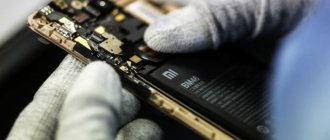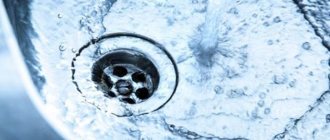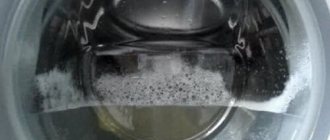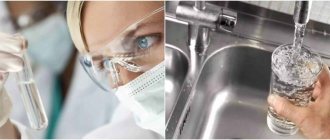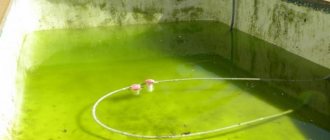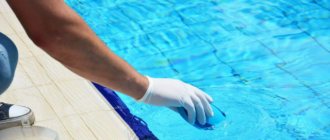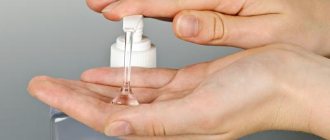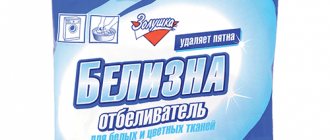There are many means for disinfecting pool water and ways to clean it. An artificial pond in a country house or country cottage is not uncommon, but you need to remember that it is not just a container of water. Water is a favorable environment for the habitat and reproduction of harmful microorganisms. It needs to be disinfected regularly to make bathing safe for health. The greens and slime that form on the bottom and walls of the tank make them slippery, creating a risk of slipping and injury. In addition, cloudy “blooming” water looks unattractive and does not make you want to plunge into it. Regular cleaning and disinfection is the key to comfortable bathing, without the risk of harm to health.
There are mechanical and chemical cleaning agents. Nets, nets and other devices are used to remove large debris. Silt deposits on the bottom and walls are removed using submersible vacuum cleaners. Most designs have filters installed. To remove small suspended matter that the filter cannot catch, special chemicals are used - coagulants. When cleaning, do not forget about hydromassage equipment, if you have one installed. During operation, persistent deposits accumulate on its elements, which can be removed using special chemicals for hot tubs.
Pool chemistry based on chlorine and other oxidizing agents as a method of disinfection and control of “blooming” water is not suitable for everyone. Disinfectants are quite expensive and can cause allergic reactions.
You can maintain the purity of water with the help of a “folk” remedy that is affordable and is probably found in every home - brilliant green.
What factors influence the method of cleaning a pool?
To determine what is best to disinfect, you need to take into account the initial state of the water and operating conditions. Experts recommend paying attention to the following points:
- Location. Designs come in open and closed types. The first ones are used outdoors, so pollen, dust, and small debris regularly get into the water.
- Load density. The more people swim, the more often it is necessary to carry out sanitary treatment of water and preventive measures. For example, a swimming pool at a dacha can be disinfected once a month, while tanks installed on the territory of sports complexes are processed weekly.
- Features of operation. This takes into account the age and physiological characteristics of visitors. For example, people in poor health may experience an allergic reaction.
- Bacteriological background. Each locality has its own set of pathogens and causative agents of dangerous diseases. Therefore, when choosing the best way to disinfect a pool, you need to take into account the characteristics of this microflora and select means aimed at its destruction.
In this case, the quality of the water itself must be taken into account. In particular, closed reservoirs are usually filled using a centralized water supply system, where the water is already treated at a treatment plant. Swimming pools on private plots are traditionally filled with water from wells and boreholes, which leads to more intense pollution and blooming.
How to paint fabric with brilliant green: recipe
Housewives often like to experiment. For these purposes they use a variety of aniline dyes. You can use them to dye an old T-shirt or tulle. The most interesting thing is that brilliant green was originally created as an aniline dye. And only later it turned out that this product kills microorganisms. Using brilliant green, you can paint your favorite curtains or dress.
Instructions for dyeing fabric with green paint:
- Pour hot water into the basin. Its temperature should be 60 °C. After this, pour in the green stuff. For 5 liters of water you will need approximately 10 ml of brilliant green.
- After this, immerse the fabric in a container with the solution and hold for 30-60 minutes. After this, rinse the fabric thoroughly.
- Prepare a container with clean water. For 5 liters add 25 ml of vinegar. Rinse green-dyed clothes in this solution.
- Dry the fabric. This is the best way to dye natural fabrics and organza. In this case, the coloring is uniform. Synthetics often stain.
Paint fabric green
How often to disinfect pool water
To disinfect the water in a pool at your dacha, it is better to use long-acting agents. Impact disinfection with drugs with a high concentration of the active substance is carried out at intervals of 2-4 weeks.
Indoor swimming pools that are filled with tap water are treated at intervals of 1 month. During intensive use, for example in the summer, the intervals for disinfection measures are reduced.
Preventive measures are carried out constantly.
Criterias of choice
The choice of tablets for the pool is made taking into account several factors:
- type of pool, its size;
- initial composition of water;
- operating conditions of the pool;
- degree of workload, intensity of use;
- the state of the water at the time of purification.
The main indicator is the condition of the water at the time of purification. Sometimes urgent and effective measures are required to remove greenery, lighten or remove excess chlorine.
However, other factors are no less important, since they affect the rate of pollution and create conditions for the appearance of certain components and impurities.
There are items that are undeservedly ignored by users - the pH level and the degree of water hardness. People know little about the first indicator and do not attach due importance to it, and they do not know how to cope with the second, believing that this is such a local feature.
You can perform shock cleaning followed by preventive treatment, or introduce a complex composition to remove all existing contaminants.
The choice also depends on the age and health status of the users. There are chemicals that are contraindicated for children or people with various diseases or allergic reactions. This point must be taken into account in any case so as not to harm users.
Particular attention is paid to children's cups, for which special tablets should be used that are safe and do not give side effects.
Pool disinfection rules
Disinfection measures are carried out in accordance with the requirements of SanPin 2.13678-20. The document details general sanitary rules, including how to disinfect pool water and how often.
It is recommended to follow the following rules:
- monitor the maximum permissible concentration of the active substance;
- during intensive processing, the existing content of drugs in water is taken into account;
- products that can cause allergic reactions in children and the elderly are not used;
- take into account the intended purpose of the selected reagent.
The recommended dosage of each drug and the maximum permissible concentration of the active substance are indicated by the manufacturer on the packaging of the selected reagent.
Frequency of use
The frequency of use of perhydrol depends on its concentration:
- less than 30% – once a week;
- 37% or more – once every 2-3 weeks.
The frequency of water purification depends on how often the pool is used and how many people swim in it.
If the frequency of use is small, the frequency of adding perhydrol is maintained according to these rules. As the number of people increases, it is recommended to clean at least once a week.
Zelenka has less antiseptic properties . If used as the only cleaning method, it is recommended to add at least 1 time per week.
Chemical methods of pool disinfection
You can disinfect pool water with reagents. This is a classic technique that is based on chemical reactions of the active component with organic and inorganic substances. Sanitary and hygienic measures are carried out in several ways.
Chlorination
An effective and fast-acting method of pool disinfection, which uses preparations based on hypochlorous acid. The option is suitable for complex disinfection - chlorine destroys most known microorganisms.
Considering that the drugs are based on an oxidizing agent, its effect can be neutralized upon contact with alkaline solutions. Therefore, during processing it is important to monitor the pH level of the water. The lower this indicator, the more effective the disinfection is.
To control the acid-base balance you can use:
- litmus tests;
- electronic testers.
The optimal pH level for effective chlorine disinfection should vary between 6.5% -7.4%.
Watch the video about whether the danger of chlorine for pool disinfection really exists or is it far-fetched:
Bromination
The effect of bromine on water is similar to chlorine-containing preparations, but this technique gives a long-lasting effect. In addition, during the processing process there is less of a specific smell. However, the solution is not suitable for outdoor pools - bromine does not have stabilizers, so it decomposes under the influence of ultraviolet rays. At the same time, bromine-containing products are not demanding on the pH level of water.
The drugs are produced in the form of tablets, where the optimal concentration of the active substance has already been calculated. Throw the product into water and wait until it is completely dissolved.
Ozonation
The advantage is that ozone destroys bacteria that chlorine and bromine cannot deal with. Therefore, to achieve maximum results, the listed disinfection options are best used in combination.
To ozonate water, three methods are used to obtain gas in the required concentration:
- chemical reaction;
- electrical impulses;
- UV reactors.
The method is effective, but unsafe: the oxygen used in ozonation is explosive and can cause damage to the respiratory tract.
Active oxygen
This is the disinfection of pool water with hydrogen peroxide. The method is safe, with the correct dosage of the drug does not cause reactions even in people prone to allergies. There is no smell during processing.
The disadvantages include a relatively short period of action. In addition, hydrogen peroxide only kills bacteria, but cannot cope with germinating algae.
Ionization
This is water purification with silver ions. For this purpose, special equipment is used that generates copper and silver ions. Passing through this filter, the water is saturated with these elements, getting rid of any bacteria. At the same time, most of the ions remain in the filter and continue to disinfect the passing water, which provides a long-lasting effect.
In terms of processing speed, ionization is significantly inferior to ozonation and other methods discussed above, so this technology is more suitable for prevention or used in combination with other disinfection measures.
See what a pool disinfected by ionization looks like in practice:
Zelenka
This is the most affordable way to disinfect water at home. Zelenka can be used to disinfect water in small outdoor pools in your garden. To disinfect water with brilliant green, you need to follow the proportion: 1 bottle per bucket of water.
Real video review of the use of brilliant green as a pool disinfectant:
Other traditional methods are suitable as an alternative:
- copper sulfate - 0.3 grams per 1,000 liters;
- pool salt in a concentration of 2.5-3 ppm;
- potassium permanganate;
- white.
How to dye your hair with brilliant green: recipe
Nowadays highlighting, coloring and dyeing in the ombre style are in fashion. Youth subcultures also love various experiments with their appearance. This is dyeing curls green and using strands of non-standard shades.
Instructions for dyeing hair green:
- Please note that this coloring is quite extreme, so if possible, use high-quality dyes intended for this.
- If you still decide to use brilliant green, then be prepared for the fact that not only your hair, but also your skin, forehead, and ears can be colored.
- Squeeze some hair balm or conditioner into the container. Pour a bottle of brilliant green into the balm. 10 ml of solution is enough. Mix the substance thoroughly.
- Be sure to put on gloves and apply the product to your curls. 20 minutes is enough for the curls to color.
- After the time has elapsed, wash your curls until the water becomes clear. You will need a lot of water.
- If after dyeing part of the head is colored, and the ears and forehead also turn green, do not be upset. Pour a little lemon juice into the alcohol and soak the cotton wool with the product. Wipe the green areas with the solution.
- The green color will last quite a long time. You won't be able to wash it off right away. If you need to do this urgently, contact your hairdresser. There, a special wash is used for these purposes.
Dye your hair green
Reagent-free methods of water purification
Such methods of disinfecting pools do not involve the use of chemically active substances. Disinfection is carried out using equipment that generates ultrasonic waves or electrical pulses.
Ultraviolet
UV disinfection is based on the absorption of ultraviolet radiation by nucleic acids, as a result of which any pathogenic microflora loses the ability to develop and reproduce. Ideally, ultraviolet irradiation should be combined with bromination or chlorination of the pool water.
The method is safe for health and does not change the chemical composition of water. However, UV irradiation is only effective while the unit is operating and is not suitable for disinfecting surfaces. Ultraviolet light will not help in combating large particles and suspensions.
Operation of an ultraviolet installation in a country pool:
Ultrasound
An expensive but effective method of water disinfection. Ultrasonic waves destroy pathogenic bacteria, destroying their shell at the molecular level. Unlike most of the methods discussed, ultrasonic vibrations have a complex effect, therefore, in addition to bacteria, they help get rid of algae.
Indications for use
Zelenka is used for the following purposes:
- antiseptic treatment - elimination of pathogenic bacteria, mainly gram-positive and gram-negative cocci, diphtheria bacillus;
- fungicidal effect – destruction of fungi;
- prevention or elimination of turbidity.
The effect of hydrogen peroxide is slightly different:
- discoloration of green algae;
- destruction of pathogenic fungi and bacteria with a wide spectrum of action;
- prevention and elimination of turbidity and water blooms.
Hydrogen peroxide actively eliminates pathogens, but retains the acid-base property of water. It is much more effective than brilliant green, so it is added when the effect of one chemical is not enough.
Preventive measures
Prevention when disinfecting a pool is that a disinfectant in a minimum concentration must be constantly present in the water. This ensures consistent destruction of harmful bacteria and pathogens.
Chlorine-based tablets do an excellent job of this task:
- "Chlorocide";
- "Marcopolus Chemical Chloritex";
- "Goodhim".
The drugs are sold in ready-to-use concentrations and used in accordance with the manufacturer's recommendations.
Covering
To prevent the heated water from cooling down and clogging it, it is recommended to cover the frame pool. The following methods are used for this:
Film - the use of light bubble film will protect the water from loss of debris and retain heat.
The dark solar film helps absorb sunlight, thereby heating the water. The film prevents evaporation and is easy to apply and clean.- Trampoline cover - usually sold complete with frame pools. Along the perimeter of the dense canvas there are clamps with which it is attached to the edges of the pool. The disadvantage of a trampoline cover is that it is labor-intensive to install, but it maintains the water temperature well.
- Polycarbonate covering - arched aluminum structure with walls made of transparent polycarbonate. The structure can move on rails installed along the pool. This covering is bulky and costs more than film and trampoline. Its advantages are: the ability to swim even in cold weather, reliable protection against debris, insects and the penetration of pets.
Read more about how to cover a frame pool here.
Processing agents
All existing tools are designed to perform specific tasks. Complex (multifunctional) preparations are capable of performing only preventive treatment.
As a rule, they perform primary cleaning, after which they use specialized compounds designed to remove certain types of microorganisms.
All compositions can be divided into 2 groups:
Chlorine.
The first group is used very widely, since chlorine-based compounds show high efficiency. It must be borne in mind that cleaning is not carried out with chlorine itself, but with the help of hypochlorous acid (it is called “free chlorine”).This is an active substance that produces almost no specific odor. Chloramines smell strongly, familiar to everyone from hospital smells, or from the atmosphere in public swimming pools. If treated water emits a characteristic odor, it is necessary to increase the concentration of the composition (and not vice versa, as many believe).
- Chlorine-free preparations. Does not emit odors and is considered completely safe. Such compositions can be used on bowls of small and medium volume (up to 20 m3). As a rule, chlorine-free products are used to treat water in children's pools, as well as if any of the family members are intolerant to chlorine preparations.
Alternative options to clean and disinfect the tank
If you have an individual intolerance to brilliant green, you can use alternative options, such as:
- Slaked lime.
- Copper sulfate.
- Baking soda.
- Lemon acid.
When processing with these agents, it is necessary to strictly follow the rules and dosages. Otherwise, there is a high risk of getting burns to the skin and respiratory tract.
Heating
The latter is advisable to install in regions with prevailing clear weather.
This device is placed in direct sunlight. When the water temperature cools to a certain point, the solar heater sensors are activated and the pump begins to pump water from the pool to the heating tank. The heated water is discharged into the pool.
The operating principle of a heat pump is also based on the accumulation of heat from the environment - soil, air. The most optimal solution for private and summer cottages is considered to be an air source heat pump. It is economical, environmentally friendly and able to operate at any air temperature.
Another heating method is to use black solar film. Its smooth surface attracts solar heat, which accumulates in air bubbles and then warms the water.
This film allows you to increase the water temperature by as much as 10-15 degrees, it protects the pool from debris, and is easy to install and remove.
You can find out how to heat water in a frame pool here.
What can I mix with for greater effectiveness?
If the flowering of the bowl does not go away when using brilliant green, it is recommended to make a solution using several ingredients.
Additional components may be:
- hydrogen peroxide (37%);
- blue;
- salt.
It is recommended to pre-combine these substances, although they can be administered separately.
To exclude an allergic reaction or skin burn, it is necessary to start swimming after cleansing with peroxide only after 12 hours.
